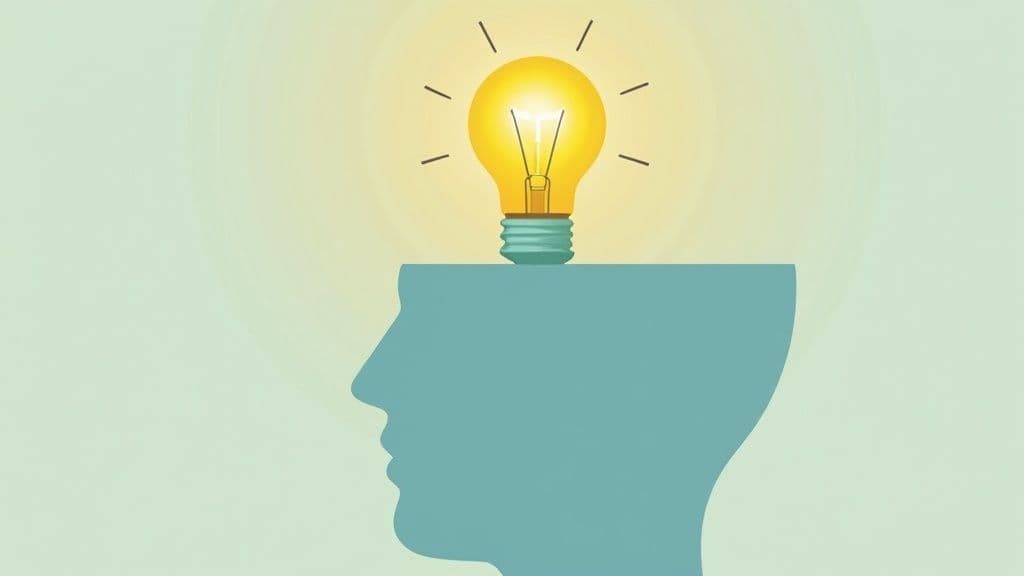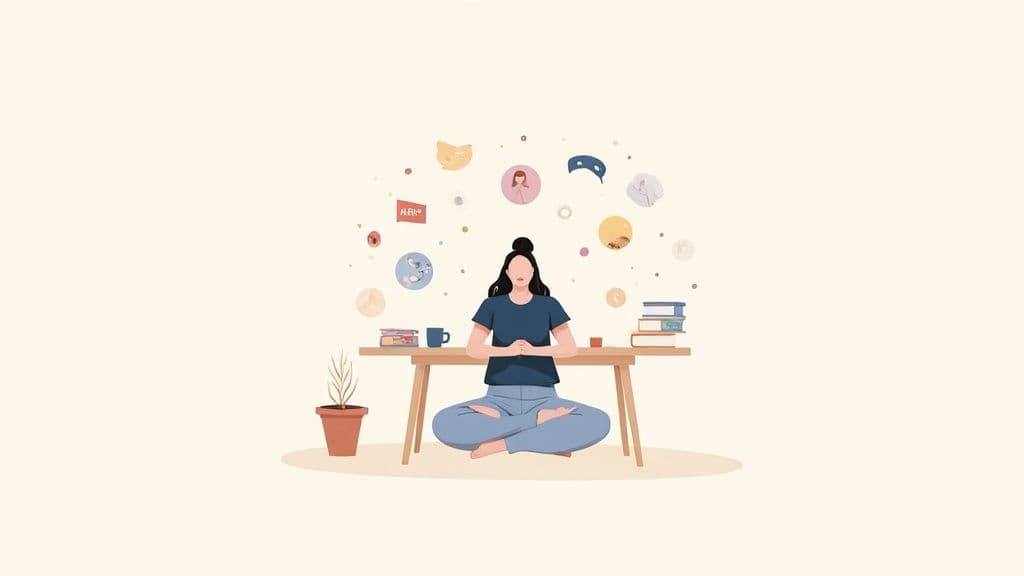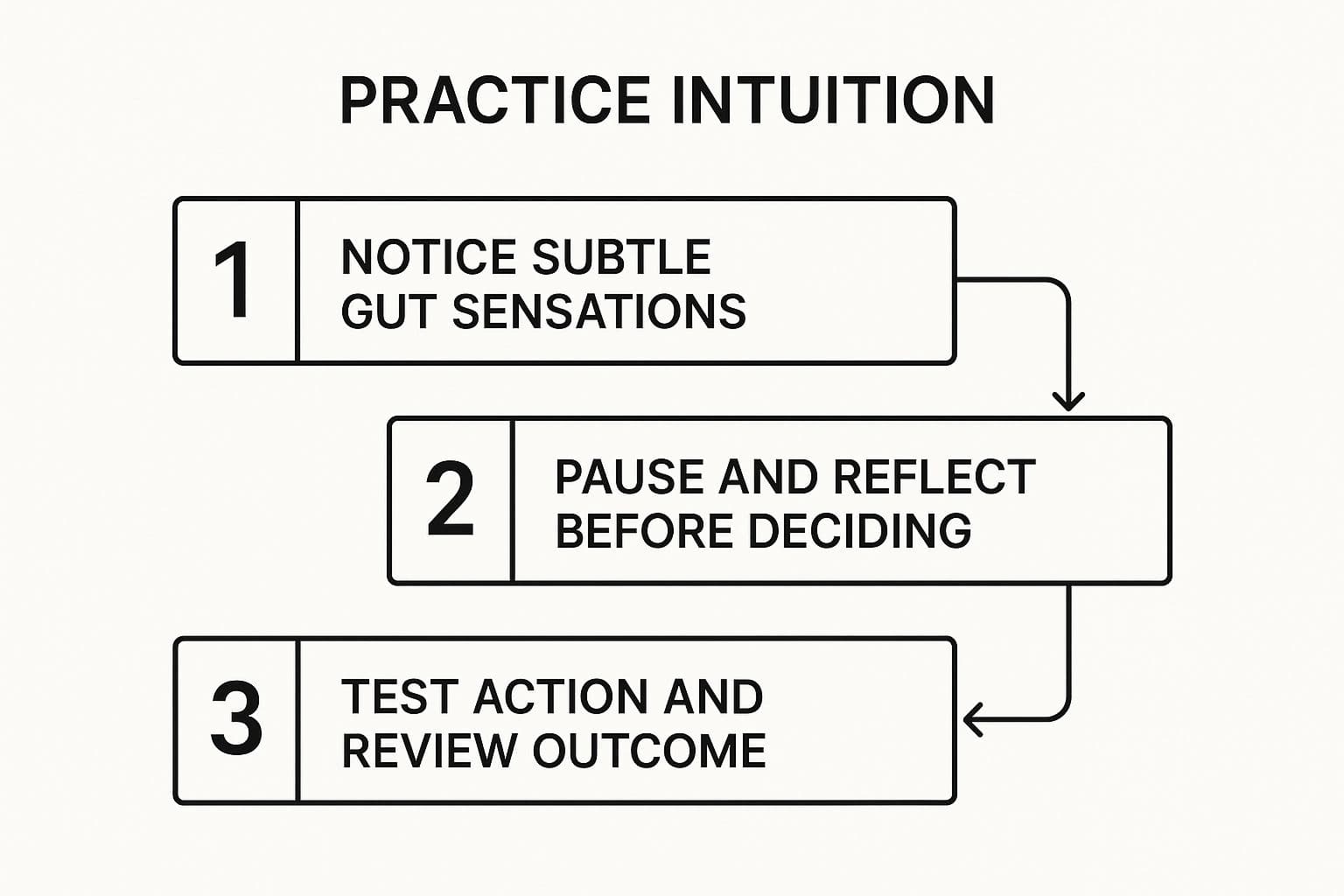Learning to trust your intuition isn’t a mystical trick reserved for a few. It’s a practical skill you can develop with simple daily habits. This guide shows clear, actionable steps—mindfulness, body awareness, reflective journaling, and low-stakes practice—to help you quiet mental noise and make wiser, more confident decisions.
July 16, 2025 (5mo ago) — last updated November 7, 2025 (1mo ago)
Improve Intuition: Practical Ways to Trust Your Gut
Practical, science-backed techniques to sharpen intuition: mindfulness, body awareness, journaling, and daily exercises to help you trust your gut.
← Back to blog
Improve Intuition: Practical Ways to Trust Your Gut
Summary: Practical, science-backed techniques to sharpen intuition: mindfulness, body awareness, journaling, and daily exercises to help you trust your gut.
Introduction
Learning to trust your intuition isn’t a mystical trick reserved for a few. It’s a practical skill you can develop with simple daily habits. This guide shows clear, actionable steps—mindfulness, body awareness, reflective journaling, and low-stakes practice—to help you quiet mental noise and make wiser, more confident decisions.

How to Genuinely Improve Your Intuition
Sharpening intuition is not about fortune-telling. It’s a learnable skill, like playing an instrument or strengthening a muscle. The work is mostly about tuning out the static of everyday life and the internal chatter that drowns out quieter, wiser signals.
Your intuition communicates through gut feelings, flashes of insight, or a quiet sense of knowing. Modern life often trains us to ignore those signals in favor of cold data. To restore balance, combine practices that lower stress, heighten body awareness, and create feedback loops that prove your hunches over time. Research into heuristics and judgment first highlighted these cognitive shortcuts in the 1970s, reshaping how we think about intuition and bias1.
Move Past Built-In Biases
We all rely on mental shortcuts, or heuristics, which can skew judgment. To develop reliable intuition, you must acknowledge and counteract those habits. The core practices that work together are:
- Mindfulness and meditation to reduce mental noise and increase clarity.
- Somatic awareness to read physical signals—tightness, warmth, ease—as meaningful data.
- Reflective journaling to record hunches and outcomes, building trust through evidence.
These practices don’t replace logic. The goal is alignment: when head and gut agree, your decisions are clearer and more authentic.
A Practical Path to Building Inner Trust
Treat this as getting to know a person—your deeper self. With patience and curiosity you’ll learn to pause and ask, “What is this feeling trying to tell me?” Below are tangible exercises to help you separate genuine intuitive hits from fear-based reactions. Combining mindfulness, body awareness, and structured reflection—such as frameworks available at The Life Purpose App—helps you form a reliable inner compass.
Core Practices for Developing Intuition
| Practice | Primary Benefit | How It Works |
|---|---|---|
| Mindfulness & Meditation | Mental clarity | Reduces mental noise and overthinking so subtle signals can surface. |
| Somatic Awareness | Body intelligence | Teaches you to interpret physical sensations as data. |
| Reflective Journaling | Builds trust | Logs hunches and outcomes so you can measure accuracy over time. |
| Numerology (via The Life Purpose App) | Personalized insight | Offers a symbolic framework to interpret recurring themes and timing. |
| Real-World Exercises | Practical application | Tests small hunches in low-stakes situations to build confidence. |
Each practice reinforces the others: meditation clears space to notice the body, and journaling turns impressions into verifiable patterns.
Create Mental Space with Mindfulness
Intuition is a quiet voice. To hear it, you must lower the volume on daily stress and constant notifications. Mindfulness isn’t about making your mind blank; it’s about creating enough space to notice what’s already there. Even short, consistent practice reduces stress and increases present-moment awareness2.
Simple Breathing Exercise
Try this three-minute reset:
- Find a quiet spot and sit comfortably with a straight back.
- Close your eyes and breathe in through your nose for a count of four, hold briefly, then exhale slowly through your mouth.
- Focus on the sensation of the breath. When your mind wanders, gently bring it back without judgment.
A few minutes a day trains your ability to return to the present moment. That basic skill makes it easier to tell the difference between a passing anxious thought and a real intuitive nudge.
Apply Mindfulness in Real Life
Before a difficult conversation, try a short breathing reset. Calming your nervous system opens the door for a wiser response—perhaps a more empathetic opening line or a clearer sense of what you truly want to say.
Body-scan meditation is another useful technique: lie down, close your eyes, and move attention slowly from your toes to your head, noticing sensations without judgment. This strengthens the mind-body connection that underpins intuitive awareness.
Listen to Your Body’s Innate Wisdom
Intuition often arrives as a bodily sensation. Phrases like “gut feeling” have a basis in how our bodies signal us. These physical cues—called somatic markers—are part of the body’s language for guiding decisions and emotions3.

To strengthen intuition, rebuild the conversation between mind and body. Start with small check-ins: before judging someone or making a choice, pause and notice how your body reacts. A sense of ease often points toward alignment, while tightness or constriction can signal misalignment.
Tuning Into Somatic Markers
Try these simple practices:
- The Doorway Check-In: Use passing through a doorway as a trigger to notice your emotional and physical state for a second.
- The Decision Scan: Picture Option A, scan your body for sensations, then do the same for Option B. Often one option will feel lighter or more settled.
Physical health affects clarity too. The gut-brain connection shows how much our physical state influences mental signals and decision-making4.
Use Reflective Journaling to Find Patterns
Mindfulness and somatic awareness help you notice intuition. Journaling is how you prove it. Recording hunches and outcomes creates a feedback loop that builds trust over time. This systematic approach turns vague feelings into measurable insights.
How to Journal for Intuition
Use a dedicated notebook and make entries whenever you notice a significant hunch or choice. Try these prompts:
- “What was my very first, unfiltered feeling about this person or situation?”
- “What specific physical sensations did I notice?”
- “Which subtle red flags or green flags did I initially ignore?”
- “Did my intuition clash with logic? If so, how?”
- “What was the final outcome, and how did it line up with my initial feeling?”
Track entries in a simple log so you can spot trends. Over time you’ll collect clear evidence of when your intuition is reliable and when fear or wishful thinking misled you.

Tracking Your Intuitive Accuracy
| Date | Situation/Decision | Initial Gut Feeling | Action Taken | Outcome & Reflection |
|---|---|---|---|---|
Consistent logging makes patterns obvious. After a few clear matches between gut feeling and outcome, you’ll naturally start to trust your inner guidance more.
Give Your Intuition a Framework with Numerology
If you find symbolic frameworks helpful, numerology can add structure to your reflections. It doesn’t predict the future. Instead, it offers archetypal language to help you interpret recurring themes and timing in your life. Using a Life Path number as a lens can sharpen questions you ask during meditation or journaling.
Tools like The Life Purpose App make it easy to explore these symbolic prompts and apply them to decisions and self-reflection.
Research shows that intuitive problem-solving can improve with experience and that giving intuition structure helps it mature into a reliable skill6.
Practical Example
If you’re choosing between a safe job and a risky venture that excites you, and your Life Path theme emphasizes freedom and change, that framework can validate the pull toward the new path. It won’t make the choice for you, but it provides a helpful lens for reflection.
Common Questions About Building Intuition
This learning process raises predictable questions. Below are concise answers to common concerns.

What if My Intuition and Logic Disagree?
Pause and gather more information. Conflicting signals are an invitation to dig deeper, not a reason to panic. Use the tension to ask clarifying questions, scan your body for how each option feels, and journal to see which signal proves reliable over time.
How Can I Tell Intuition from Fear?
Intuition often feels neutral and clear, like a calm knowing. Fear tends to be loud, repetitive, and story-driven, accompanied by tightness, racing heart, or shallow breathing. A quick body scan can help you tell the difference.
How Long Does It Take to See Results?
You can notice small shifts in weeks with consistent practice. Deep, unshakeable trust develops over months and is strengthened by reflective journaling that documents outcomes.
Ready to discover the unique intuitive framework your life is built upon? The Life Purpose App provides instant access to your personal numerology, helping you understand your core gifts, challenges, and the life path you were born to live. Download it at https://lifepurposeapp.com.
Quick Q&A
Q: What are the fastest ways to start trusting my gut? A: Begin daily three-minute breathing, add a weekly body-scan, and log every meaningful hunch with outcome notes.
Q: How do I avoid confusing fear with intuition? A: Do a short body scan. Fear usually produces tightness and rapid thoughts; intuition feels steadier and neutral.
Q: How do I build evidence that my intuition can be trusted? A: Keep a structured intuition log. Record the initial feeling, physical sensations, the action you took, and the outcome. Patterns will emerge.
Discover Your Life Purpose Today!
Unlock your true potential and find your life’s purpose.
